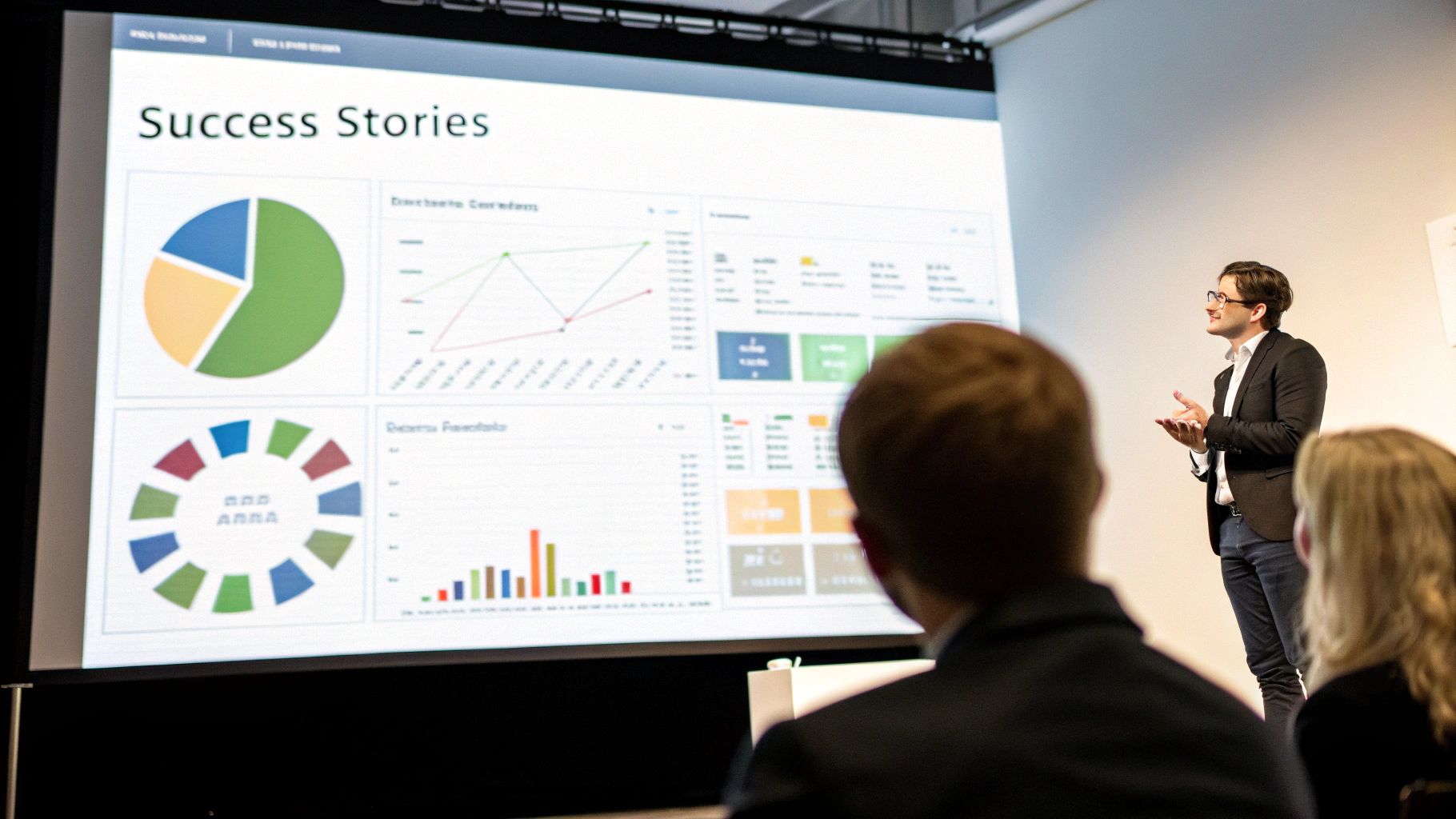Demystifying ROI Marketing: Beyond the Numbers

Understanding what ROI marketing is is critical for any UK business aiming for sustainable growth. It's more than just a calculation; it's a strategic framework for decision-making and resource allocation. Successful ROI marketing goes beyond simply tracking numbers. It involves understanding the wider impact of your marketing efforts on your business.
For example, imagine two UK companies with similar online advertising campaigns. Company A focuses only on click-through rates and cost per click. Company B tracks these, but also monitors customer lifetime value and conversion rates. Company B's more holistic approach to ROI better positions them for long-term profitability. This broader perspective is especially important in the competitive UK market, where customer acquisition costs can be significant.
Understanding the evolving nature of marketing evaluation in the UK is also essential for optimizing ROI. UK businesses prioritize different metrics when evaluating marketing performance, with sales being the most important at 22%. However, 7% of businesses also consider ROI a key metric. This shows a shift in UK marketing evaluation, with businesses increasingly looking beyond immediate sales to long-term value and efficiency. Understanding ROI helps optimize marketing spend across different channels, ensuring effective resource allocation for the best possible returns. Learn more about UK digital marketing statistics here. This underscores the importance of understanding not only what works, but why.
Moving Beyond Vanity Metrics
Many UK businesses get caught up in tracking vanity metrics. These are impressive-sounding numbers that don't necessarily correlate with business growth. Likes, shares, and website traffic are examples of potentially misleading vanity metrics. They might look good on a report, but don't tell the whole story.
True ROI marketing focuses on value drivers. These are the metrics that directly impact revenue and profitability, including customer lifetime value, conversion rates, and customer acquisition cost. By understanding these key metrics, UK businesses can make informed decisions about marketing investments and maximize their returns.
This requires a shift from focusing on activity to focusing on outcomes. Instead of measuring the number of social media posts, a business should track the leads generated through social media, and the conversion rate of those leads. This nuanced approach is essential for understanding the real impact of marketing activities on ROI.
The Science of Calculating Marketing ROI That Actually Works
Calculating marketing Return on Investment (ROI) isn't simply plugging numbers into a formula. It's a detailed process involving careful measurement, analysis, and adapting strategies to suit the specific dynamics of the UK market. Understanding the interplay of various factors and their effect on your bottom line is paramount.
Beyond Basic Formulas: Frameworks for UK Marketers
Effective UK marketers utilize robust frameworks, going beyond basic calculations, to accurately gauge campaign performance. They factor in the nuances of individual channels, recognizing that the immediate impact of paid search differs greatly from the long-term benefits of content marketing.
Different marketing activities require different timeframes for ROI assessment. Analyzing the ROI of a brand awareness campaign on social media necessitates a longer timeframe compared to evaluating a short-term sales promotion.
Establishing meaningful baselines is also vital. This involves comparing current performance to historical data and industry benchmarks. For example, a 20% increase in website traffic may appear positive, but it's less impressive if the industry average is 30%.
From Vanity Metrics to Value Drivers
Distinguishing between vanity metrics and value drivers is essential for calculating meaningful ROI. Vanity metrics, such as social media likes or page views, might appear impressive but don't always reflect business growth. Value drivers, conversely, directly influence revenue and profitability.
Key value drivers include metrics like customer lifetime value (CLV), conversion rates, and customer acquisition cost (CAC). This is especially crucial in the competitive UK market. Understanding the true value of your marketing investments is paramount.
Conversion Rates in the UK Market
One crucial marketing ROI metric in the UK is the average conversion rate, hovering around 2.5% depending on the specific industry. This figure represents the percentage of leads that become paying customers. A low rate suggests potential issues with lead quality or the sales process itself.
If a business generates 1,000 leads and 25 convert into customers, the conversion rate is 2.5%. The formula is simple: (Number of Customers / Number of Leads Generated) * 100. Understanding and optimizing this rate is fundamental to robust ROI analysis. More insights on conversion rates can be found here.
Implementing Effective Tracking Systems
UK businesses need comprehensive tracking systems to capture the full impact of marketing efforts. These systems should move beyond simply measuring clicks and conversions, and instead track the entire customer journey. This provides a more holistic view of marketing performance.
Integrating various analytics platforms and applying attribution models can help accurately assign credit to different touchpoints. This granular understanding allows businesses to identify successful strategies, pinpoint areas for improvement, and allocate marketing budgets effectively to maximize ROI.
To understand the different methods of calculating marketing ROI, consider the following table.
ROI Calculation Methods Comparison
This table compares different methods of calculating marketing ROI, highlighting their strengths, weaknesses, and ideal use cases.
| Calculation Method | Formula | Best For | Limitations |
|---|---|---|---|
| Simple ROI | (Revenue – Marketing Cost) / Marketing Cost | Quick assessments and single campaigns | Doesn't account for long-term value or complex customer journeys |
| Customer Lifetime Value (CLV) | Average Purchase Value * Average Purchase Frequency * Average Customer Lifespan | Long-term strategies and customer retention programs | Can be complex to calculate accurately and requires extensive data |
| Cost Per Acquisition (CPA) | Marketing Cost / Number of Conversions | Measuring campaign efficiency and lead generation | Doesn't reflect the value of a customer beyond the initial conversion |
| Return on Ad Spend (ROAS) | Revenue from Ads / Cost of Ads | Evaluating the performance of paid advertising campaigns | Can be misleading if not considered alongside other metrics like CLV |
This table highlights the varied approaches to calculating marketing ROI, each with its own strengths and limitations. Choosing the right method depends on the specific marketing goals and the available data.
Selecting the appropriate calculation method ensures a more accurate and insightful assessment of marketing effectiveness, leading to better informed decisions and improved ROI.
High-ROI Marketing Channels That UK Businesses Overlook

While many UK businesses concentrate on well-known platforms, some high-return marketing channels remain underutilized. Identifying these channels is key to maximizing marketing effectiveness and achieving a strong return on investment (ROI). After all, what is ROI marketing without exploring every possibility?
The Power of Email Marketing in the UK
Email marketing remains a highly effective channel in the UK, especially for businesses focused on building strong customer relationships and nurturing leads. Email allows for personalized communication, targeted campaigns, and direct engagement with customers. This makes it powerful for driving conversions and building brand loyalty.
For example, a UK-based clothing retailer could use email to notify subscribers about exclusive sales, new product releases, and personalized style recommendations. This targeted approach contributes significantly to email marketing’s impressive ROI.
In fact, for every pound invested, UK businesses can see a return of approximately £38.33. This underscores the channel’s effectiveness in delivering substantial financial gains. More detailed statistics can be found here. The ease of tracking key metrics, like opens, clicks, and conversions, makes email marketing valuable for measuring and optimizing ROI.
Untapped Potential in Niche Social Media Platforms
Beyond established platforms like Facebook and Instagram, niche social media platforms offer unique opportunities for UK businesses. These platforms often cater to specific interests and demographics, allowing for highly targeted advertising and community engagement.
For example, a UK craft brewery could leverage a platform like Untappd to connect with beer enthusiasts, promote new brews, and build a loyal following. These niche platforms can deliver significantly lower acquisition costs compared to more saturated channels. This can be particularly advantageous for smaller businesses or startups with limited marketing budgets.
Rethinking Traditional Channels for the UK Market
While digital marketing is prominent, traditional channels still hold value for UK businesses. Print advertising in local publications, strategic partnerships with community organizations, and targeted direct mail campaigns can effectively reach specific audience segments. This is especially true for businesses targeting older demographics or specific geographic areas.
For instance, a local UK bookstore might partner with a nearby café to offer discounts to their customers, expanding reach and tapping into a new customer base. These collaborations can strengthen brand presence and drive tangible results. Combining traditional and digital strategies can create a powerful synergistic effect, maximizing reach and engagement within the UK market.
To help visualize the potential returns, let's examine the average ROI for various marketing channels:
UK Marketing Channel ROI Comparison
This table presents average ROI figures for different marketing channels in the UK market, helping businesses compare potential returns.
| Marketing Channel | Average ROI | Implementation Cost | Time to Results |
|---|---|---|---|
| Email Marketing | £38.33 per £1 spent | Low | Relatively Quick |
| Niche Social Media | Varies, potentially high | Low to Moderate | Varies |
| Local Partnerships | Difficult to quantify, but potentially high | Low to Moderate | Varies |
| Direct Mail | Moderate | Moderate | Can be slow |
| Paid Search (PPC) | Varies greatly | Moderate to High | Quick |
As this table demonstrates, while Paid Search can deliver quick results, the cost can be substantial. Email marketing, on the other hand, offers a consistently high ROI at a lower cost. Exploring niche social media and local partnerships provides opportunities for targeted reach and potentially high returns, though measuring ROI can be more complex. Finally, direct mail, while potentially slower, can still be effective for specific demographics and geographic areas. The key takeaway is to diversify your marketing mix and explore channels that align with your target audience and budget.
Metrics That Truly Drive Marketing ROI Success

Measuring the success of your marketing efforts requires a deeper dive than just surface-level numbers. To truly grasp ROI marketing, especially within the UK, we need to explore the metrics that directly impact profitability. These key performance indicators (KPIs) provide valuable insights into campaign effectiveness and shape future strategies.
Beyond Vanity: Focusing on Value-Driven Metrics
While metrics like website traffic and social media engagement offer some insights, they don't always correlate with business growth. For a true understanding of marketing ROI, UK businesses should prioritize value-driven metrics that directly link to revenue and profitability.
-
Customer Lifetime Value (CLV): This crucial metric predicts the total revenue expected from a single customer throughout their relationship with a business. Understanding CLV helps UK businesses make informed decisions about customer acquisition costs and long-term marketing strategies.
-
Conversion Rates: Tracking conversion rates across various channels highlights which marketing activities effectively turn leads into paying customers. Optimizing conversion rates is essential for improving ROI in the competitive UK market.
-
Customer Acquisition Cost (CAC): This metric measures the cost of acquiring a new customer. Minimizing CAC while maximizing CLV is fundamental to successful ROI marketing, particularly in the UK's competitive business landscape.
Connecting the Dots: CAC and CLV in the UK
Leading UK brands are increasingly emphasizing the relationship between CAC and CLV. Analyzing these metrics together provides a comprehensive understanding of marketing investments. For example, if a UK business spends £50 to acquire a customer (CAC) and that customer generates £200 in lifetime revenue (CLV), the ROI is substantial. This data-driven approach enables smarter investment decisions.
Engagement Metrics That Predict Conversion
Not all engagement metrics are equally valuable. Some may appear impressive in reports but lack correlation with increased sales. UK businesses must identify engagement metrics that truly predict conversion.
-
Time on Page/Site: Analyzing user dwell time on specific pages can reveal content quality and user interest. High time-on-page often indicates valuable, resonant content, increasing conversion likelihood.
-
Click-Through Rates (CTR): Measuring CTR for various calls to action (CTAs) helps determine which messaging and offers resonate most with UK audiences. A high CTR suggests effective messaging and can drive conversions.
-
Lead Quality: While not a single metric, assessing lead quality is paramount. A high volume of leads is ineffective if they don't convert into paying customers. UK businesses should prioritize generating qualified leads genuinely interested in their offerings.
Building a Framework for Your Business
Identifying the right metrics for your specific business model and customer journey is essential for successful ROI marketing in the UK. This requires a deep understanding of your target audience, sales process, and marketing channels.
By implementing robust analytics platforms and reporting structures, UK businesses can effectively track these metrics and make data-driven decisions to optimize marketing ROI. This involves shifting from vanity metrics to value-driven KPIs.
This strategic approach empowers UK businesses to allocate resources effectively, optimize campaigns, and achieve sustainable growth in a competitive market. Analyzing the right metrics allows UK businesses to not only measure their marketing ROI but also continually improve it.
Traditional Vs. Digital: The Hybrid ROI Marketing Reality
The debate surrounding traditional versus digital marketing is no longer a key concern for UK businesses aiming to boost their return on investment (ROI). Savvy marketers now understand that a hybrid approach – a blend of both – yields the strongest results. This requires understanding what ROI marketing truly means in our multi-channel environment.
This integrated strategy acknowledges that each channel plays a unique role in the customer journey. Imagine a UK financial services company. They might use targeted Facebook ads to generate leads, followed by personalized email campaigns to nurture them. Finally, they might send a direct mail piece with a special offer. This multi-touch strategy is particularly effective in the UK, where consumers interact with various platforms.
Balancing Digital Efficiency With Traditional Trust
Premium UK brands are finding success combining digital marketing's efficiency with the trust fostered by traditional media. This hybrid approach creates deeper connections with target audiences. One example is using programmatic advertising for highly targeted online ads, supported by print ads in high-quality publications. This reinforces brand prestige and builds credibility.
Direct-to-consumer companies in the UK are also adopting this blended approach to cut through the digital noise. While they often rely on digital marketing, they also utilize traditional channels like television and radio advertising. This helps them reach wider audiences and establish brand recognition.
UK advertising ROI studies show significant returns, both short and long term. Advertising generates a short-term profit ROI of £1.87 per pound invested, rising to £4.11 over time. TV advertising contributes 54.7% of advertising-generated profit, with an average ROI of £5.61 per pound spent. Learn more about advertising and its positive effect on profits here. This underscores the impact of consistent campaigns, especially for mediums like TV, in building brands and driving both immediate and long-term profit.
Channel Attribution in a Hybrid World
Measuring ROI effectively in a hybrid marketing setting requires robust channel attribution models. These models look beyond last-click attribution, considering the impact of various touchpoints across the customer journey. This multi-touch attribution enables UK businesses to accurately assess the contribution of both digital and traditional channels to their overall ROI.
This nuanced perspective recognizes that traditional channels, like print advertising or public relations, can significantly influence customer behavior, even without directly leading to an online conversion. A holistic view of channel attribution helps UK marketers make data-driven decisions regarding budget allocation and channel optimization.
Case Studies: UK Brands Embracing the Hybrid Model
Several UK brands are seeing impressive results from integrated marketing:
- A UK retail chain boosted in-store traffic by combining targeted online advertising with local radio promotions, guiding customers to specific stores.
- A B2B software company saw significant lead generation increases by combining targeted LinkedIn campaigns with direct mail sent to key decision-makers.
These cases highlight the synergistic effect of combining traditional and digital channels, amplifying reach, engagement, and ultimately, ROI. This holistic approach moves beyond simply defining ROI marketing and focuses on achieving it.
By using similar strategies, UK businesses can optimize their channel mix. This optimization is based on a deep understanding of their target audience and customer journey, rather than departmental preferences or outdated assumptions about channel effectiveness. This integrated approach is increasingly vital for navigating the complex and evolving UK marketing landscape.
Building an ROI-Focused Marketing Machine That Scales

Transitioning to a truly ROI-driven marketing approach requires a significant shift in how organizations think. It's more than just measuring different metrics; it's about transforming how your entire business views and values the marketing function. This section explores practical steps for building a scalable, ROI-focused marketing operation, using examples from successful UK businesses.
Restructuring for ROI: Teams, Tech, and Processes
Many UK companies are restructuring their marketing teams, technology, and internal processes to gain a clearer picture of their ROI. This often means breaking down traditional departmental silos and fostering greater collaboration between marketing, sales, and finance. For example, some UK businesses are creating cross-functional teams dedicated to specific customer segments or product lines. This helps improve communication and keeps everyone aligned on ROI goals.
Investing in the right technology is also crucial. Marketing automation platforms, CRM systems, and analytics dashboards can provide a unified view of marketing performance, enabling data-driven decisions. Integrating these tools and streamlining data flows allows UK businesses to gain a more accurate understanding of their marketing ROI.
Gaining Executive Buy-In: Overcoming Legacy Thinking
One of the biggest challenges in becoming ROI-focused is gaining executive buy-in. Many organizations still prioritize traditional metrics over demonstrable financial impact. This is especially true for some UK businesses accustomed to traditional marketing methods. However, by presenting marketing data using the language of finance – focusing on profitability, customer lifetime value, and return on ad spend – marketers can effectively showcase their value.
Creating clear, concise dashboards that visualize key ROI metrics is essential for communicating marketing's impact to executives. These dashboards should highlight the direct connection between marketing activities and revenue generation, showcasing marketing's contribution to the bottom line.
Building Dashboards That Speak to Finance
Forward-thinking UK marketers are building dashboard systems that demonstrate marketing's financial impact in a way that finance teams understand and respect. This means moving beyond vanity metrics like likes and shares, instead focusing on metrics that directly correlate with revenue and profitability. For instance, a UK e-commerce company might track conversion rates, average order value, and customer acquisition cost, showing how marketing investments generate tangible financial returns.
These dashboards should be easily accessible and customizable, allowing executives to drill down into specific data and gain a deeper understanding of marketing performance. This transparency builds trust and facilitates productive, data-driven discussions about budget and resource allocation.
Continuous Improvement: Frameworks for ROI Optimization
Building an ROI-focused marketing machine is an ongoing process. UK businesses should implement regular review cycles to analyze performance, identify areas for optimization, and adapt strategies based on data insights. This could involve A/B testing different marketing messages, experimenting with new channels, or refining targeting strategies to improve conversions and maximize ROI.
It's also important to recognize warning signs that your ROI approach might not be accurately reflecting true performance. For example, if your reported ROI is extremely high but your overall business growth is stagnant, your measurement system may be flawed. Regularly auditing your tracking systems and refining your attribution models is vital for accurate ROI measurement.
By embracing these strategies, UK businesses can build a scalable, ROI-focused marketing operation that drives sustainable growth. This involves not just adopting new metrics but also transforming organizational culture, fostering collaboration, and prioritizing data-driven decisions.
Ready to transform your TikTok Shop sales into predictable profits? Mergoio offers real-time analytics and forecasting to optimize your e-commerce performance. Visit Mergoio today to learn more and join our beta program.

Leave a Reply